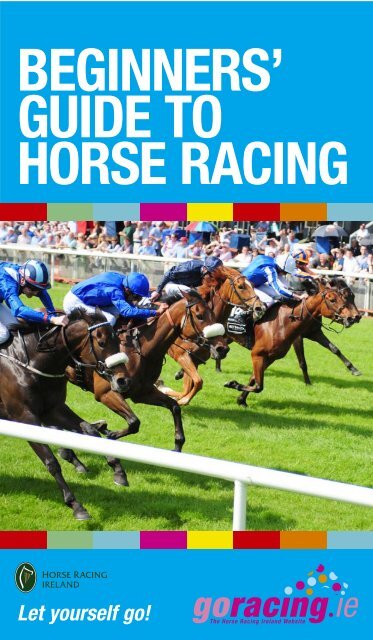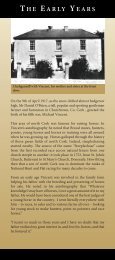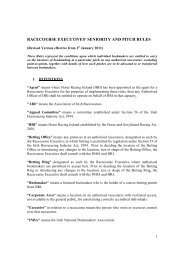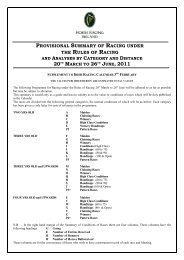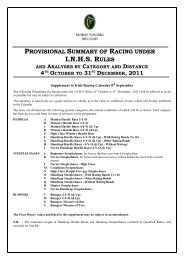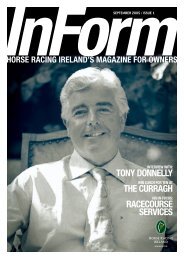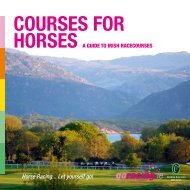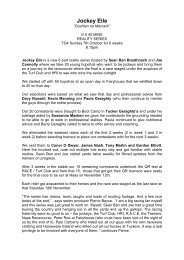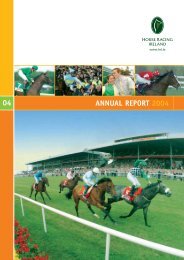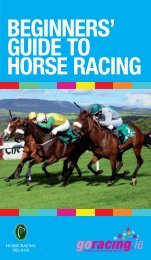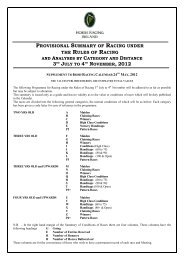BEGINNERS GUIDE.indd - Horse Racing Ireland
BEGINNERS GUIDE.indd - Horse Racing Ireland
BEGINNERS GUIDE.indd - Horse Racing Ireland
You also want an ePaper? Increase the reach of your titles
YUMPU automatically turns print PDFs into web optimized ePapers that Google loves.
<strong>BEGINNERS</strong>’<br />
<strong>GUIDE</strong> TO<br />
HORSE RACING<br />
Let yourself go!
CONTENTS:<br />
INTRODUCTION 3<br />
A DAY AT THE RACES<br />
BASIC TIPS 5<br />
MAIN FESTIVALS 6<br />
ORIGINS OF RACING 8<br />
TYPES OF RACES 11<br />
STARS OF THE TURF<br />
HORSES 14<br />
STARS OF THE TURF<br />
JOCKEYS 16<br />
HOW TO PICK A WINNER 21<br />
THE FORM <strong>GUIDE</strong> 22<br />
THE PARADE RING 24<br />
ALTERNATIVE METHODS! 25<br />
BETTING 27<br />
TOTE 28<br />
BOOKMAKERS 29<br />
RACING SPEAK 30<br />
www.goracing.ie
<strong>BEGINNERS</strong>’<br />
<strong>GUIDE</strong> TO<br />
HORSE RACING<br />
INTRODUCTION<br />
Sometimes it’s good to be a beginner. The beginner’s mind<br />
has no fixed ideas to get in the way of understanding a subject…<br />
In <strong>Horse</strong> <strong>Racing</strong> there are many tales of the rank beginner who trumps<br />
the expert and this should give you confidence as you start out to take<br />
part in this wonderful sport. Sport is too small a word for it actually.<br />
<strong>Racing</strong> is a sport, surely, and one at which <strong>Ireland</strong> excels; it is also a<br />
huge industry employing over 16,500 people and a social occasion<br />
without equal and a very special ‘slice of Irish life’.<br />
You will find, however, that a little knowledge is a useful thing. This<br />
guide will take you through the first steps towards understanding what<br />
is happening out there on the course. What does a good horse look like?<br />
What is the ‘going’? What is all this about weights and distance? What is<br />
a bumper? Do I wear a hat?<br />
Your enjoyment of racing will grow as you begin to know how it all works,<br />
as will your appreciation of the great traditions and skills which are part<br />
of Irish <strong>Racing</strong>.<br />
Above all, relax and enjoy… Let yourself go!<br />
page 3
term no.1<br />
beginners’ guide<br />
WHOOOHOO/YEAAAAHEY - /wu’huu / jea’hay/ n &v<br />
Exultant sound made when the horse you backed<br />
has won. You won’t notice yourself doing it, but you<br />
will. Tune the frequency and decibel level to suit<br />
your vocal chords.<br />
www.goracing.ie
A DAY AT THE RACES<br />
BASIC TIPS<br />
Tired of the same old social scene, same old stale faces and<br />
places? Then go along and have a fun day out in the open air,<br />
because no matter where you are in the country there is probably<br />
a race meeting within reach. Come with friends and family on a<br />
warm Summer’s day and wander about with a cold drink. Come<br />
in Winter, snugly wrapped up and warmed up by a couple of hot<br />
drinks and lively banter in the bars.<br />
There is no dress code in Irish<br />
racing so you can dress up or<br />
dress down, shirt and tie, slacks,<br />
old dress, new dress, hat or not,<br />
jeans and t-shirt, it doesn't matter,<br />
just go.<br />
But if you are looking for a chance<br />
to show off that new outfit there<br />
are prizes for the best-dressed<br />
lady (and sometimes man) at<br />
most major meetings and, at the<br />
bigger meetings and festivals, a<br />
designated ladies day.<br />
However, before leaving home, (well<br />
it is <strong>Ireland</strong>!) it's a good idea to<br />
check the weather forecast for the<br />
day because sometimes you will<br />
need to bring a coat or an umbrella.<br />
Pick up your daily paper which<br />
will have all the racing news<br />
and information you will need<br />
and remember, the WWW is packed<br />
with racing sites - goracing.ie will<br />
give you an intro to every Irish<br />
racecourse, with all the races,<br />
breaking news and special offers.<br />
page 5
MAIN FESTIVALS<br />
In fact why not make a mini-holiday out of racing by going to a<br />
racing festival? Festivals take place at all times of the year and there<br />
is one to suit your lifestyle. They are a celebration not just of racing<br />
but of Irish culture and offer a wide range of experiences, depending<br />
on where you go and what time of year it is.<br />
SO, WHICH ONE DO YOU FANCY?<br />
Fairyhouse.<br />
One of the biggies. The Grand<br />
National on Easter Monday is the<br />
highlight of this Festival held just<br />
10 miles from Dublin. Easter Sun/<br />
Mon/Tues.<br />
Cork.<br />
Down south they have their own<br />
Easter party in Mallow town. Easter<br />
Sat/Sun/Mon.<br />
Punchestown.<br />
The best jump racing of the year<br />
with Champions from Britain<br />
and <strong>Ireland</strong> fighting it out at the<br />
spacious Co. Kildare track. 5 days<br />
at end of April.<br />
The Curragh.<br />
Top quality flat racing. With<br />
the best flat horses in Europe<br />
competing at the Classics, the<br />
Guineas Festival in May, the Derby<br />
at the end of June, the Oaks in<br />
July and the Irish St Leger &<br />
National Stakes in September.<br />
Bellewstown.<br />
The annual 3 day evening racing<br />
festival on the hill of Crockafotha,<br />
Co. Meath, after the Irish Derby.<br />
Killarney.<br />
Escape from your hectic day-today<br />
routine and enjoy the most<br />
laidback racing in the country amid<br />
breathtaking scenery. 4 days in<br />
mid-July and 4 days in August.<br />
www.goracing.ie
Galway.<br />
7 fantastic mid-Summer racing<br />
days and nights in the most vibrant<br />
city in <strong>Ireland</strong>. Guaranteed to be an<br />
electric atmosphere every day. One<br />
visit and you'll be hooked. 7 days<br />
end of July.<br />
Tramore.<br />
Fun-filled days in the popular<br />
seaside resort. Something for<br />
everyone: sun, sand, sea and...<br />
spectacular racing. 4 days<br />
mid-August.<br />
Leopardstown/Limerick.<br />
After the feast on Christmas Day<br />
indulge yourself in a feast of racing<br />
that won't give you indigestion. A<br />
great way to spend the festive days<br />
with friends and relations.<br />
26th-29th December.<br />
There are many other<br />
festival-style meetings,<br />
check out www.goracing.ie<br />
Listowel.<br />
Enjoy the last of the Summer wine<br />
and weather. Great racing in the<br />
Kingdom at the “Harvest Festival”.<br />
7 days mid-September.<br />
page 7
THE ORIGINS OF RACING<br />
The horses that compete in racing are members of the thoroughbred<br />
breed. Their origins can be traced back to 3 Arabian stallions that<br />
were imported into England in the early eighteenth century and<br />
were bred with native stock to produce a faster, stronger breed.<br />
So, all racehorses are in fact distantly related. Thoroughbreds<br />
are now to be found in all parts of the world and many of the best<br />
are bred in <strong>Ireland</strong>.<br />
THEY COMPETE IN 2 DIFFERENT TYPES OF RACES:<br />
FLAT RACING<br />
These races are run over distances ranging from 5 furlongs ( 5 / 8 mile<br />
or 1000 metres) to 20 furlongs (2 1 / 2 miles or 4000 metres) and are started<br />
from stalls. As the name suggests, there are no obstacles in flat racing.<br />
The flat racing season runs from mid-March to mid-November.<br />
Flat horses mature quickly and start running as 2 or 3-year-olds.<br />
The Curragh in Co. Kildare has been the headquarters of flat racing in<br />
<strong>Ireland</strong> since the early 18th century and according to history the ancient<br />
Celtic Kings held racing there.<br />
NATIONAL HUNT OR ‘JUMP’ RACING<br />
All jump races are contested over at least 2 miles and the horses<br />
have to jump a number of obstacles. This makes for spectacular viewing.<br />
These races are started from a tape barrier. Jump horses mature more<br />
slowly and don’t run until they are 4 or 5-year-olds. Jump racing goes<br />
on all year round but its main season runs from November until the end<br />
of April. Some flat horses also run in jump races when they get older.<br />
www.goracing.ie
THERE ARE 3 TYPES OF JUMP RACE: STEEPLECHASE,<br />
HURDLE AND POINT TO POINT.<br />
STEEPLECHASE<br />
Run over “fences” which vary<br />
in size. The word steeplechase<br />
was coined in County Cork<br />
in 1752. Two gambling men,<br />
Edmund Blake and Cornelius<br />
O’Callaghan wanted to settle a<br />
bet as to whose horse was faster.<br />
So they organised a race across<br />
country from the steeple of the<br />
church in Buttevant to that of<br />
St Mary’s in Doneraile. Hence<br />
the name, which is often<br />
shortened to “chase”.<br />
HURDLE<br />
Run over obstacles measuring<br />
about 3 feet 1 inch in height.<br />
POINT TO POINT<br />
Run over fences on designated<br />
farmland throughout the country<br />
in the Spring and Autumn. This<br />
is basically the nursery for young<br />
jump horses and many champions<br />
have emerged from this circuit.<br />
<strong>Racing</strong> at its most rustic.<br />
page 9
term no.2<br />
beginners’ guide<br />
HANDICAP - /’hændi,kæp/ n&v(r)<br />
A race in which the weights are calculated by an<br />
official assessor (called a handicapper). The better<br />
class horses carry the highest weights while the<br />
lesser class horses carry lower weights. The idea is<br />
to give all horses an equal chance of winning.<br />
www.goracing.ie
FLAT RACE TYPES<br />
FLAT MAIDEN<br />
A race for horses that have not won<br />
a flat race before. These races are<br />
normally confined to an age group. A<br />
2-Y-O maiden is for horses aged 2 year<br />
old only that have not won a race while<br />
there are also 3-Y-O maiden races and<br />
ones for older horses as well.<br />
FLAT HANDICAPS<br />
A race in which the weights are<br />
calculated by an official assessor<br />
(called a handicapper). The better<br />
class horses carry the highest weights<br />
while the lesser class horses carry<br />
lower weights with the top weight<br />
generally being 10st extending down<br />
to a bottom weight of 8st 4lb. A<br />
Nursery is a handicap for 2 years old<br />
only. Each flat horse normally receives<br />
a rating from the Official Handicapper<br />
after he has raced at least 3 times and<br />
he can then enter a handicap. Ratings<br />
generally go from as low as 47 to<br />
as high as 120+. The flat handicaps<br />
normally have a top and bottom rating<br />
and some of the typical types of<br />
handicaps are listed as follows:-<br />
47-60, 50-70, 50-80, 60-80, 60-90,<br />
60-100, 70-100<br />
<strong>Horse</strong>s rated above 100 can run in<br />
handicap races but generally don’t as<br />
they would have too much weight to<br />
carry. These horses can be aimed at<br />
listed and pattern races.<br />
CONDITIONS RACE<br />
A notch below listed standard, there<br />
are certain conditions for qualification.<br />
Sometimes these races are confined<br />
to winners of one race, winners of two<br />
races, winners of races of a certain<br />
value or from a certain date. Previous<br />
winners generally have to carry extra<br />
weights in terms of penalties.<br />
LISTED/PATTERN RACE<br />
These races are more valuable races<br />
and generally attract the better class<br />
horses. A horse would usually be<br />
rated above 90 to compete in listed<br />
races and the weights would include<br />
penalties for winning certain types<br />
of races. A Group 3 race is a slight<br />
step up from listed level with horses<br />
generally rated 100 taking part while<br />
a Group 2 race attracts horses rated<br />
from 100 to 115. The most prestigious<br />
and important races are Group 1<br />
races. These are very valuable races<br />
and the winners of these races<br />
generally become stallions at the end<br />
of their careers or, if they are fillies,<br />
they become valuable broodmares<br />
when they retire. There are 12 Group<br />
1 races in <strong>Ireland</strong> at the moment with<br />
five of these called Classic races.<br />
CLASSIC RACES<br />
The 2000 Guineas, The 1000 Guineas,<br />
The Derby, The Oaks and The St Leger<br />
are the 5 Classic races in <strong>Ireland</strong>.<br />
Fillies can run in all five Classic races<br />
with colts only allowed to run in the<br />
2000 Guineas, The Derby and The St<br />
Leger. The 1000 and 2000 Guineas are<br />
run over a mile with the Derby and the<br />
Oaks held over a mile and a half while<br />
the St Leger is run over a distance of<br />
one mile and six furlongs. In <strong>Ireland</strong>,<br />
the 5 Classic Races are all held at the<br />
Curragh Racecourse in Co. Kildare.<br />
page 11
term no.3<br />
LENGTH - /’lenkt/ n.<br />
beginners’ guide<br />
The approximate length of a horse: about 8 feet.<br />
Winning margins are measured in lengths, ranging<br />
from 1/2 a length to a distance (more than 20<br />
lengths). Smaller winning margins are a short-head,<br />
head or a neck.<br />
www.goracing.ie
NATIONAL HUNT RACE TYPES<br />
BUMPER<br />
A special type of flat race for horses<br />
beginning their national hunt careers.<br />
These races are confined to horses aged<br />
between 4 and 7, run over a distance of<br />
at least 2 miles up to 2 1⁄2 miles, and<br />
ridden by Qualified Riders (amateurs).<br />
A horse can only race in a maximum of<br />
six bumper races unless he wins one<br />
in which case he can race in winners<br />
bumpers, but as these races are viewed<br />
as introductory races, the competitors<br />
normally go hurdling or steeplechasing<br />
as soon as they can.<br />
MAIDEN HURDLE<br />
A race for horses that have not won a<br />
hurdle race or a steeplechase but they<br />
may have won flat races or bumper races.<br />
<strong>BEGINNERS</strong> STEEPLECHASE<br />
A race for horses that have not won a<br />
steeplechase but they may have won<br />
hurdle races, bumper races or flat races.<br />
NOVICE<br />
A novice hurdle is for horses that have<br />
not won a hurdle race before the start of<br />
the season (the season usually starts at<br />
the end of the Punchestown Festival in<br />
late April). A novice steeplechase is for<br />
horses that have not won a steeplechase<br />
before the start of the season.<br />
HANDICAP<br />
Just like the flat, there are handicap<br />
races for hurdlers and for steeplechasers<br />
with the better class horses carrying the<br />
highest weights (usually 11st 12lb) right<br />
down to the lower class horses carrying<br />
a minimum of 9st 10lb. Ratings generally<br />
go from 80 to above 170. Races are<br />
scheduled to incorporate the lowest class<br />
of horses (generally 80 to 95) while there<br />
are also races with rating bands of 81-<br />
109, 81-116, 81-123, 81-130. The likes<br />
of the Irish Grand National, The Galway<br />
Hurdle, The Galway Plate, The Thyestes<br />
Chase and the Kerry National don’t have<br />
rating bands to allow all types of horses<br />
to run with again the highest rated<br />
horses carrying the heavier weights.<br />
CONDITIONS RACE<br />
Similar to the Flat, condition races have<br />
certain qualification requirements with<br />
penalties applying to previous winners.<br />
There are races confined to horses that<br />
have not won more than one hurdle/<br />
steeplechase or two hurdles/steeplechases<br />
while other races may have<br />
qualifications concerning the value of<br />
previous races won.<br />
LISTED/GRADED RACE<br />
Much like the pattern races on the flat,<br />
these type of races attract a better<br />
class of horse. There are Grade 3, 2 or<br />
1 races with the highest value races<br />
being the Grade 1 events. There are no<br />
penalties in Grade 1 races and some<br />
of the bigger ones in <strong>Ireland</strong> would be<br />
the likes of the Irish Champion Hurdle<br />
or the Hennessy Cognac Gold Cup at<br />
Leopardstown. Some Graded races are<br />
used as a stepping stone to the famous<br />
Cheltenham Festival in mid-March and<br />
invariably when a horse wins a Graded<br />
race, one of the first questions their<br />
connections are asked will be<br />
concerning whether the horse will be<br />
going to Cheltenham.<br />
page 13
STARS OF THE TURF<br />
HORSES<br />
The horses are the stars of the show because without them there<br />
would be no show. It's because of their speed and bravery that we<br />
can all enjoy this great sport of racing. Here we pay tribute to some<br />
legendary Irish horses.<br />
NIJINSKY (1967)<br />
Nijinsky, named after a famous<br />
Russian ballet dancer, was trained<br />
in Co. Tipperary by the legendary Dr.<br />
Vincent O’Brien to be the Champion<br />
flat horse of Europe both as a two and<br />
three-year-old (1969/70). He is widely<br />
acclaimed as one of the best flat<br />
horses of all time. As a two-year-old<br />
he won all of his five races in <strong>Ireland</strong><br />
and England while the following year<br />
he won his first six races including<br />
the Irish and English Derby and the<br />
English ‘Triple Crown’. It was the ease<br />
of his victories that made him so great<br />
but he met with his first defeat in the<br />
Prix de l’Arc de Triomphe in France<br />
and was also beaten in his next race.<br />
He was then retired to stud and his<br />
genes have exerted a huge influence<br />
on the modern thoroughbred. Dr.<br />
O’Brien was recently voted the most<br />
influential racing figure of all time by<br />
readers of the “<strong>Racing</strong> Post”.<br />
ARKLE (1957)<br />
Arkle was the best steeplechaser ever.<br />
It’s a fact that brooks no argument.<br />
The great horse was named after a<br />
mountain in the highlands of Scotland<br />
though he was bred and trained in<br />
North Co. Dublin. His trainer Tom<br />
Dreaper sent him out to win 27<br />
races both here and in England from<br />
1962-66. His wins numbered all the<br />
important steeplechases including the<br />
Cheltenham Gold Cup three times and<br />
there is a statue commemorating him<br />
at Cheltenham. He was so superior<br />
to other horses of the time that<br />
sometimes special provision had to<br />
be made for him to carry more weight<br />
than normal to give other horses a<br />
chance, and he would still beat them!<br />
Arkle is still much revered today and<br />
is referred to simply as “Himself”<br />
with readers of the “<strong>Racing</strong> Post”<br />
voting him as the most popular horse<br />
of all time. There are several books<br />
celebrating his life and career.<br />
www.goracing.ie
SEA THE STARS (2006)<br />
Perfection. That is the only word to<br />
describe Sea The Stars. The pedigree,<br />
the looks, the temperament and most<br />
importantly the God-given ability to<br />
run faster than any other horse on<br />
the planet, he had it all. At 8, 10 or<br />
12 furlongs, on soft or firm ground<br />
and everything in between, on flat or<br />
undulating tracks, in <strong>Ireland</strong>, England or<br />
France, Sea The Stars proved imperious.<br />
He took the Prix de l’Arc de Triomphe,<br />
the Irish Champion Stakes, the Coral<br />
Eclipse, the Epsom Derby, the English<br />
2000 Guineas, etc. His remarkable<br />
trainer John Oxx and ice-cool jockey<br />
Michael Kinane did not put a single toe<br />
out of step throughout his entire career<br />
and no pair of professionals in racing<br />
were more deserving. Many will hope<br />
that Sea The Stars’ impact in the world<br />
of horse racing has only just begun<br />
and one can only hope that his legacy<br />
will grow even more when his progeny<br />
begin to reach the racecourse in 2013.<br />
MOSCOW FLYER (1994)<br />
Moscow Flyer was the first horse that<br />
Brian Kearney owned. “He changed<br />
my life,” he said. He changed every<br />
Irish racing fan’s life too. He was the<br />
peoples’ horse and was loved by<br />
them. Trained by Jessica Harrington<br />
and ridden by Barry Geraghty he won<br />
27 races over hurdles and fences,<br />
earning €1.4 Million! He won three<br />
times at Cheltenham including the<br />
Champion Chase twice. Moscow<br />
Flyer was a specialist two-mile<br />
steeplechaser. Often referred to as<br />
the “speed chaser” these horses are<br />
probably the most exciting racehorse,<br />
by virtue of the speed and accuracy at<br />
which they jump. At his best Moscow<br />
Flyer was spectacular and imperious<br />
though his ‘Achilles Heel’ was to<br />
sometimes make mistakes at the<br />
fences but if he cleared every fence<br />
he won; no question. He retired in<br />
2006 and lives a life of leisure. There<br />
is a book commemorating his career.<br />
page 15
STARS OF THE TURF<br />
JOCKEYS<br />
Jockeys have the most exciting and glamorous job in racing. It<br />
can be dangerous at times but they love it and that's why they do<br />
it. Anybody who has ridden a horse can appreciate what a thrill<br />
it is to be galloping along at 40 miles per hour and get paid for<br />
it. However it's not simply a matter of getting up on a horse and<br />
going fast. Every race and every horse is different so tactics need<br />
to be worked out to try to win the race. Some horses are front<br />
runners while others need to be kept in reserve early in the race<br />
to finish fast. There is a difference in size between Flat and Jump<br />
jockeys. Flat jockeys are smaller because weight carried in flat<br />
races are lower than over jumps. Here is a brief profile of a few<br />
top Irish jockeys.<br />
RUBY WALSH (1979)<br />
As a jockey Ruby Walsh is subtle,<br />
strong and stylish; he is the ultimate<br />
jump jockey. He makes a very difficult<br />
job look effortless but then the very<br />
best at their profession always make it<br />
look easy. In his case less is more, his<br />
genius is to get horses into a natural<br />
rhythm during a race and not interfere<br />
with them too much thus enabling<br />
them to jump better, and win! It is all<br />
instinctive with him.<br />
Ruby (short for Rupert) who hails from<br />
Kildare, is the son of the well-known<br />
trainer and RTE TV presenter Ted<br />
Walsh and so has been riding horses<br />
all his life.<br />
He was Champion Qualified Jockey<br />
while still at school and has since<br />
been Irish Champion Jockey many<br />
times and has won many HRI National<br />
Hunt Awards. He has won most of<br />
the big races in the UK and <strong>Ireland</strong><br />
including the Aintree Grand National,<br />
Irish Grand National and Cheltenham<br />
Gold Cup though despite his grey hair<br />
he is still young.<br />
Ruby also has an amazing ability<br />
to come back from injury, the<br />
occupational hazard of a jump<br />
jockey’s life, and his many broken<br />
bones and other injuries would<br />
make most ‘normal’ people wince.<br />
www.goracing.ie
PAT SMULLEN (1977)<br />
Pat Smullen has been established as<br />
one of the top riders in Europe for many<br />
years now and with age very much still<br />
on his side, his best years look to still be<br />
ahead of him. His greatest attribute as<br />
a rider is his consistency and he rarely<br />
loses a race he should have won, which<br />
is the mark of a great jockey.<br />
Having become Dermot Weld’s stable<br />
jockey in 1999, Pat Smullen has been a<br />
regular visitor to the big-race winner’s<br />
enclosure both in <strong>Ireland</strong> and abroad. He<br />
has won three Irish Classics on horses<br />
trained by Weld, namely the Derby on<br />
Grey Swallow (2004) and the 1,000<br />
Guineas on Nightime (2006) and Bethrah<br />
(2010). He also enjoyed an English<br />
Classic win on Refuse To Bend in the<br />
2,000 Guineas in 2003. One of Pat’s<br />
most prolific partners was the Weldtrained<br />
Vinnie Roe, with Smullen riding<br />
him to no less than four wins in the Irish<br />
St Leger as well as a win in the Prix<br />
Royal Oak at Longchamp.<br />
Smullen was crowned Champion<br />
Jockey for the sixth time at the<br />
conclusion of the 2010 season, with<br />
his remarkable consistency proving<br />
to be significant once again. With the<br />
support of Dermot Weld to rely on, Pat<br />
Smullen can be expected to remain<br />
as one of <strong>Ireland</strong>’s leading jockeys for<br />
many years to come.<br />
page 17
term no.4<br />
beginners’ guide<br />
ON THE BRIDLE / ON THE BIT - (Expression)<br />
A horse going the pace seemingly without much<br />
effort or need for its jockey to push it. Can be deceptive<br />
as sometimes these horses will not find extra speed<br />
when their jockeys do push them at the end of a race.<br />
www.goracing.ie
NINA CARBERRY (1984)<br />
Nina Carberry is without doubt the<br />
best female jump jockey in Britain<br />
and <strong>Ireland</strong>. She has been Champion<br />
Qualified Jockey in <strong>Ireland</strong> numerous<br />
times and will surely be so many more<br />
times. Associated with the Noel Meade<br />
yard from the very outset of her career,<br />
her first win on the racecourse came<br />
when she was just 16 in the 2001<br />
Ladies’ Derby at the Curragh on the<br />
Meade-trained Sabrinski.<br />
The first of Nina’s many winners at<br />
the Cheltenham festival came in 2005<br />
on Dabiroun in the Fred Winter Hurdle<br />
for Irish trainer Paul Nolan. In 2006<br />
she became only the 14th woman<br />
ever to ride in the Grand National<br />
and in 2011, she became just the<br />
second woman to ride the winner of<br />
the Irish Grand National, scoring on<br />
Organisedconfusion, who was trained<br />
by her uncle Arthur Moore. <strong>Horse</strong><br />
racing is part of Nina’s blood as her<br />
father Tommy was a great Irish jump<br />
jockey and her brothers Phillip and<br />
Paul are prominent jump jockeys too.<br />
Nina is one of the best jockeys riding<br />
in ‘Bumper’ (special National Hunt flat)<br />
races. She is also a specialist at riding<br />
in Cross Country races such as those<br />
staged at the Punchestown Festival<br />
in April.<br />
She is still officially a ‘Qualified Rider’<br />
or amateur as they used to be known<br />
but she is anything but amateur and is<br />
as stylish and effective as any of the<br />
professional jockeys with the added<br />
attraction of being much better looking<br />
than them!<br />
JOHNNY MURTAGH (1970)<br />
Johnny Murtagh is one of the leading<br />
flat racing jockeys, not just in <strong>Ireland</strong>,<br />
but in the world. As a jockey he always<br />
has horses in the right place in a race<br />
to maximise their chance, is strong<br />
in a finish and he knows instinctively<br />
where the winning post is. However,<br />
he is particularly brilliant in the big<br />
events because he has such a cool<br />
nerve on such occasions and has won<br />
almost every major race worth winning<br />
in <strong>Ireland</strong>, Britain, Europe and some in<br />
the USA.<br />
Johnny, who comes from Navan in<br />
Meath, was proficient in many sports<br />
as a youngster including soccer and<br />
boxing, but decided to become a<br />
jockey after he attended the jockeys’<br />
training academy RACE at the Curragh.<br />
After graduating he rode his first<br />
winner as a 17-year-old for trainer<br />
John Oxx at Limerick in 1987. He was<br />
then Champion Apprentice Jockey<br />
two years later in 1989. He has been<br />
outright Champion Irish Jockey many<br />
times.<br />
Keeping his weight down under 9<br />
stone has been a constant battle for<br />
Johnny, but the fight has been worthwhile<br />
considering the outstanding<br />
career he has had so far and it isn’t<br />
over by a long way yet. Having enjoyed<br />
three immensely successful years as<br />
the retained rider for the Coolmore<br />
operation from 2008-2010, Murtagh<br />
has returned to where he began his<br />
career, with John Oxx, and he looks<br />
sure to continue at the highest level for<br />
many years to come.<br />
page 19
term no.5<br />
beginners’ guide<br />
ODDS ON - /audz /- n. pl - . /aun/ - prep., adv,. adj)<br />
Sometimes confusing - a bookmaker price. Eg. at<br />
“6 to 4 on” you have to stake 6 to win 4. This will<br />
appear as 4 /6 on bookmakers boards but is referred<br />
to as 6 to 4 on.<br />
www.goracing.ie
HOW TO PICK A WINNER<br />
That’s the $64,000 question that we would all like answered.<br />
Unfortunately, there is no simple answer to this, it is like trying to solve a<br />
jigsaw puzzle. However, if you follow the pointers below you can at least<br />
tip the odds in your favour.<br />
The American sports writer Damon Runyon famously wrote that it was<br />
difference of opinion that made horse racing. He was right. Everybody at the<br />
races has an opinion; racegoers, bookmakers, owners, trainers and jockeys.<br />
That’s part of the attraction of the sport; i.e. the fun involved in finding out who<br />
is right and it’s even better fun when it’s you.<br />
On any given day a first time racegoer could easily pick loads of winners and<br />
experienced racegoers pick none. Everybody’s opinion is equal until after the<br />
race is run...<br />
HOW TO READ A RACECARD<br />
Buying a racecard is one of the first things you should do when you arrive at<br />
the racecourse. It will contain all the information you require for your day at the<br />
races. It is a good idea to bring a pen with you because sometimes the racecard<br />
information changes on the day (non-runners, jockey changes etc). This will be<br />
announced over the loudspeaker.<br />
Below is a guide as to how to read the information on a typical racecard.<br />
page 21
THE FORM <strong>GUIDE</strong><br />
‘Form’ is the information you need to know in order to make<br />
the right decision regarding what horse to back. It consists of<br />
the following....<br />
HORSE 'FORM'<br />
Basically, has the horse been<br />
running well recently? Is it in<br />
good form? It is usually best<br />
policy to bet on a horse that has<br />
good form figures: i.e. has finished<br />
in the first 4 in at least some of it’s<br />
previous runs. The racecard will<br />
provide details of its last<br />
three races.<br />
GOING<br />
What the ground conditions are<br />
like on the course. The descriptions<br />
are as follows: heavy, soft, yielding,<br />
good, good to firm and firm. Some<br />
horses run equally well on any<br />
type of ground but many have a<br />
preference.<br />
DISTANCE<br />
It’s important that the horse has<br />
run well over a similar distance<br />
to what it’s running over on the<br />
day. Though some horses are<br />
quite adaptable beware of radical<br />
changes, up or down, from its<br />
previous run.<br />
WEIGHT<br />
An old racing adage is that<br />
weight brings horses together.<br />
The issue of weight is not so<br />
much the amount it has to carry<br />
but how much it is conceding<br />
to other horses in the race.<br />
Obviously the more weight a<br />
horse has to carry the harder it<br />
will be for it to win.<br />
www.goracing.ie
COURSE<br />
We have all heard of the ‘horses<br />
for courses’ theory. Well, it has an<br />
element of truth and certainly some<br />
horses do run better at particular<br />
courses so look out for horses that<br />
have winning course form. Often a<br />
big, long-striding horse will prefer a<br />
big, open course whereas a smaller,<br />
speedier horse will be more suited<br />
to a smaller, tighter course.<br />
SURFACE<br />
Some horses are better on an<br />
artificial, all-weather racing surface,<br />
like that at Dundalk racecourse<br />
but are not so good on natural turf<br />
courses and vice versa.<br />
TRAINER AND JOCKEY<br />
<strong>Racing</strong> is very competitive in<br />
<strong>Ireland</strong> with some of the best<br />
trainers and jockeys in the world<br />
competing here so naturally races<br />
are not easy to win. Some trainers<br />
and jockeys are specialists at<br />
certain courses, for one reason or<br />
another so bear that in mind.<br />
It is a good idea to check up<br />
whether the trainer has been<br />
having winners of late. Sometimes<br />
trainer’s go through good and bad<br />
spells and it’s definitely a positive if<br />
the stable is going well.<br />
Remember, jockeys are like any<br />
sporting performer; when their<br />
confidence is high they perform<br />
best so it’s good policy to follow<br />
one who has ridden winners<br />
recently or on the day. A confident<br />
jockey can motivate the horse and<br />
vice versa.<br />
EXTRA INFO<br />
Every racecard has a guide written<br />
by a racing professional so that is<br />
worth reading.<br />
If you want extra information read<br />
the racing section in the daily<br />
papers. For serious punters there<br />
are dedicated racing publications<br />
such as the “<strong>Racing</strong> Post” and<br />
“Irish Field” plus specialist<br />
websites.<br />
page 23
THE PARADE RING<br />
In your quest to pick the winner it is important to look at each horse<br />
before the race. You can often pick up vibes (both positive and<br />
negative) from how they look and behave. Here are some pointers:<br />
‘GOOD VIBE’<br />
• It’s striding around<br />
purposefully, looking alert,<br />
focused and calmly taking in<br />
what is happening.<br />
• It has good muscle definition and<br />
its coat is so shiny that you can<br />
almost see your reflection in it.<br />
• It wins the best turned out<br />
award.<br />
• Basically, think of how a top<br />
athlete looks and behaves in<br />
the build-up to an important<br />
event at the Olympics and<br />
apply that to the horses.<br />
‘NEGATIVES’<br />
• It’s not relaxed, is getting upset<br />
and is generally misbehaving.<br />
• Kicking with its hind legs or<br />
pinning its ears flat against its<br />
head is a sign of bad temper.<br />
• It’s loping around lazily like<br />
a Labrador dog looking for<br />
somewhere to lie down.<br />
• Its coat looks dull and it lacks<br />
muscle definition.<br />
• It’s sweating-up a lot. A little bit<br />
of sweat is often a good sign<br />
but profuse sweating, especially<br />
between the legs, signals an<br />
agitated, nervous horse unlikely<br />
to run well.<br />
GOING TO THE START<br />
It’s also a good idea to see<br />
the horses cantering to the<br />
start to check that it moves<br />
fluently and seems comfortable<br />
on the prevailing going. All<br />
horses are different and move<br />
differently but even to a novice<br />
it will be apparent if a horse is<br />
uncomfortable on the going.<br />
DECISION TIME!<br />
Having decided which horse you<br />
want to bet on, either go into the<br />
betting ring and scrutinise the<br />
various bookmakers’ boards or go<br />
to the Tote outlets. (see p.27 for<br />
how to put on a bet)<br />
www.goracing.ie
ALTERNATIVE METHODS<br />
Of course there are several other, less conventional, but often<br />
surprisingly accurate methods of picking winners that don’t involve<br />
hours of studying!<br />
These include:<br />
• Picking the jockey’s colours that match your dress.<br />
• Picking the jockey that you think is cute (there are many of either sex<br />
who could be labelled as cute), beauty is in the eye of the beholder.<br />
• The horse’s name is an anagram of your own.<br />
• And the old reliable one of closing your eyes and picking a name of<br />
the page at random. Watch the looks on your friends’ faces when<br />
these ‘alternative’ methods pick out a 20/1 winner!<br />
page 25
term no.6<br />
beginners’ guide<br />
EACHWAY<br />
An each-way bet is 2 equal sized bets, so the total<br />
stake is twice the unit stake<br />
e.g. €5 each-way will cost a total of €10.<br />
www.goracing.ie
BETTING OPTIONS<br />
Fancy a flutter, but not sure what is right for you? Well first off,<br />
there are two options for placing your bets at the races, through<br />
the Tote or the Bookmakers.<br />
Having a bet is part of the enjoyment<br />
of the day and it adds to the excitement<br />
of watching the races. You can’t<br />
beat the feeling of seeing your horse<br />
crossing the finishing line first and<br />
winning you some cash! The beauty<br />
of betting is that you don’t have to<br />
invest a lot to scoop a win. You can<br />
play the Tote Placepot or Jackpot for<br />
as little as €1, which if you get lucky,<br />
could win you thousands! Of course,<br />
it’s not all about the winning, but it is<br />
a good feeling, especially if you have<br />
won more than your friends, making<br />
you feel so superior, at least until the<br />
next race...<br />
Remember, the rule is whoever wins,<br />
buys a round of drinks!<br />
TOTE<br />
The Tote are generally located all over<br />
the racecourse in prime locations to<br />
allow for betting no matter where you<br />
find yourself on the day. Betting is<br />
straightforward – the guide on the next<br />
page will explain exactly what to do.<br />
There are screens all over the course<br />
to give you an indication of what you’ll<br />
get paid if you win your bet. However,<br />
these can change right up to the ‘off’<br />
of the race. The Tote put their profits<br />
back into the horse racing industry to<br />
help keep this fun sport at its best.<br />
BOOKMAKERS<br />
This type of betting is also very<br />
straightforward. You can wander<br />
between the bookmakers’ pitches<br />
where they display the runners for the<br />
next race and the odds/prices that are<br />
being offered. There will be differences<br />
in their prices so look for the one who<br />
is giving the best price on your horse.<br />
To place your bet, simply tell the<br />
bookmaker: the horse’s number<br />
the type of bet i.e. win or each-way<br />
the amount you’d like to bet<br />
You will then be given a ticket confirming<br />
your bet. Keep this safe as you’ll<br />
need it to claim your winnings if your<br />
horse is successful. After the race, to<br />
claim your winnings, simply take your<br />
receipt back to the bookmaker you<br />
had the bet with and he’ll give you<br />
your money. Bookmakers operate a<br />
computerized ticket/board system.<br />
RACECOURSE BETTING SHOP<br />
This is the same as a High Street<br />
bookmaker’s shop where you write on a<br />
betting slip: the name of the horse<br />
the type of bet i.e. win or each-way<br />
the amount you’d like to bet. You hand<br />
the slip and money to the cashier and<br />
you will be given a copy of the slip. This<br />
copy must be presented back to the<br />
cashier when collecting any winnings.<br />
page 27
TOTE<br />
The Tote is the simplest way to bet at the races, with Tote betting<br />
facilities in all locations on track. The Tote give all their profits<br />
back to horse racing so by betting with them, you are contributing<br />
to the sport.<br />
The Tote is a pool betting system. Like<br />
the lotto, all money bet goes into one<br />
big pool and then that is divided by the<br />
number of winners. They offer a wide<br />
variety of bet types from the simple Win<br />
and Place to the challenging Jackpot and<br />
Pick Six. So whether you select horses<br />
because you like the name, or because<br />
you have studied the form intensely, the<br />
Tote has a bet that is right for you!<br />
THE TOTE BETS<br />
INTRODUCED<br />
WIN - Simply pick a horse to finish 1st.<br />
PLACE - A safer bet, you pick a horse<br />
you think will place in the race. If there<br />
are 5-7 runners in a race you win if<br />
your horse comes 1st or 2nd. If there<br />
are 8 -15 runners you win if your<br />
horse comes 1st, 2nd or 3rd and if the<br />
race is a Handicap with 16 or more<br />
horses running, you will win if your<br />
horse comes 4th!<br />
EACH WAY - This popular bet is a Win<br />
and a Place bet combined.<br />
EXACTA - Pick 2 horses to finish 1st<br />
and 2nd in the correct order.<br />
COMBINATION EXACTA - Pick 2 or<br />
more horses to finish 1st and 2nd in<br />
any order.<br />
TRIFECTA - Pick 3 horses to finish<br />
1st, 2nd and 3rd in the correct order.<br />
This is a good bet if you fancy a few<br />
horses in a race!<br />
www.goracing.ie
COMBINATION TRIFECTA - Pick 2 or<br />
more horses to finish 1st, 2nd and 3rd<br />
in any order.<br />
DAILY DOUBLE - Pick the winning<br />
horses in races 5 and 6 to win.<br />
PLACEPOT - The aim here is to pick<br />
horses to be placed in races 1 to 6.<br />
This bet has to be placed before the<br />
1st race and is a fun, good value bet.<br />
JACKPOT - This small stake, big<br />
win bet involves picking the winning<br />
horses of races 3, 4, 5 and 6. As the<br />
name suggests, you often see people<br />
winning big for a small investment!<br />
PICK SIX - This one is a toughie!<br />
Challenging but rewarding, this bet<br />
requires you to pick the winning<br />
horses in races 1 to 6. The Pick Six<br />
is only available on Sundays and at<br />
major festivals.<br />
MINIMUM STAKES:<br />
€2 on Win, Place & Each Way<br />
€1 on Exacta and Jackpot bets<br />
€0.50 on Trifecta and Pick Six bets<br />
€0.10 on Placepot bets<br />
€5 on Daily Doubles<br />
HOW DO I BET<br />
WITH THE TOTE?<br />
Betting with the Tote is easy! The<br />
Tote provides betting facilities all over<br />
the course, including Tote betting<br />
counters with Tote tellers, Tote selfvend<br />
machines called Touch Totes<br />
and plenty of hand held staff in the<br />
seating and corporate areas, so you<br />
will never be too far away from getting<br />
your bet on.<br />
When you are ready to place a bet,<br />
you need to simply tell the operator<br />
the following:<br />
• The race meeting<br />
• The race number<br />
• How much you want to bet<br />
• Type of bet<br />
• What the horse number is<br />
For example, ‘I would like a €10 Win<br />
bet on race two at Leopardstown on<br />
horse number 7 please’.<br />
Then the operator will give you your<br />
ticket and you are ready to go cheer<br />
your horse home!!! Remember to<br />
always make sure the ticket details<br />
are correct.<br />
And if studying the form isn’t your<br />
thing, you can always simply ask the<br />
Tote operator for a ‘Quickpick’!<br />
If you have a winner you can simply<br />
hand your ticket in to any Tote teller<br />
and collect your winnings.<br />
If you lose your Tote ticket, remember<br />
Tote customer service will do their best<br />
to help you retrieve your winnings!<br />
There is also the option of betting<br />
through a Tote Account, which offers<br />
a wide range of benefits including<br />
free racing admissions, the Tote Price<br />
Promise and more!<br />
For more on the Tote visit:<br />
www.thetote.com<br />
Call: 1850 238 669<br />
UK: 0800 804 7784<br />
Int: +353 45 491 830<br />
page 29
RACING SPEAK<br />
ALL-WEATHER: This is the term<br />
used to describe an artificial<br />
racing surface. Dundalk is the<br />
only such course in <strong>Ireland</strong> and its<br />
surface is a brand called Polytrack,<br />
a mix of sand and synthetic fibres.<br />
Many horses run equally as well<br />
on this surface as on turf, but<br />
some prefer one or the other so<br />
bear that in mind when assessing<br />
a horse’s chance in a race. There<br />
are no jump races over obstacles<br />
on an all-weather surface for<br />
safety reasons.<br />
APPRENTICE: Young professional<br />
flat jockeys who can claim a<br />
weight allowance of up to 10lbs,<br />
dependent on their age and how<br />
many winners they have ridden.<br />
There are many separate races<br />
for apprentices and they have<br />
their own Derby at the Curragh<br />
every year.<br />
BALLOTING: This is a merit based<br />
system, put in place due to safety<br />
limits on the number of horses<br />
allowed run in each race. It is<br />
often necessary for a ballot to take<br />
place and a certain number of<br />
horses will get eliminated on that<br />
particular occasion<br />
BANKER: <strong>Racing</strong> slang word for a<br />
horse that is guaranteed to win;<br />
i.e. a certainty, money in the<br />
bank. A mythological concept<br />
preached by dedicated but<br />
misguided believers because<br />
there is no such thing. Anything<br />
can and frequently does happen<br />
in horse racing so there are no<br />
certainties. That’s what makes it<br />
so exciting.<br />
BEST DRESSED LADY: This<br />
competition is held on most major<br />
race days and is sometimes as<br />
competitive as the action on the<br />
course! So ladies, if you want to<br />
show off that new outfit and win<br />
a prize keep an eye out for ladies<br />
day dates, usually on during the<br />
summer season. There is often a<br />
separate competition for men.<br />
BEST TURNED OUT: Not to be<br />
confused with the above. This is<br />
a prize given to the groom of the<br />
horse that is judged to look the<br />
best in the parade ring. Often a<br />
good pointer to a horse’s chance.<br />
BIT: A two-piece device that fits<br />
into the horse’s mouth and is<br />
attached to the reins. It allows the<br />
jockey to control and steer the<br />
www.goracing.ie
horse. There are many different<br />
types and shapes of bit and they<br />
are usually made of plastic,<br />
rubber or steel. Part of the bridle<br />
(see below).<br />
BLINKERS: A piece of equipment<br />
that goes over the horse’s head<br />
to restrict its vision and help it<br />
concentrate in a race. Some horses<br />
(like people) lose focus while doing<br />
their work! (Note: Blinkers need to<br />
be declared and their use appears<br />
on the racecard).<br />
BREEDER: The person, stud farm<br />
or organisation that bred the horse<br />
and whose name appears in the<br />
racecard. Without breeders there<br />
would be no horses to race.<br />
BRIDLE: The piece of equipment<br />
that is fitted onto the horse’s head<br />
that includes the bit and reins.<br />
There are many different types of<br />
bridle, but they are usually made of<br />
leather or nylon.<br />
CHEEK PIECES: Sheepskin bands<br />
on each side of the bridle which<br />
help keep the horse focused. They<br />
do much the same job as blinkers.<br />
Written in the racecard as C/Piece<br />
and abbreviated to (CP) in the<br />
horse’s previous form.<br />
CLERK OF THE COURSE: An<br />
employee of the Turf Club, this is<br />
the official who makes sure that<br />
the course is safe and fit for<br />
racing on the day. Each<br />
racecourse’s official racecard<br />
carries the signature of their<br />
clerk of the course.<br />
CLERK OF THE SCALES: Also an<br />
employee of the Turf Club, it is<br />
their job to ensure that the<br />
correct weight is carried by each<br />
jockey before and after a race. If<br />
a jockey weighs in with the<br />
incorrect weight the Clerk will<br />
lodge an objection with the<br />
Stewards who will hold an<br />
inquiry and that can lead to<br />
disqualification of a horse. He also<br />
has an assistant clerk.<br />
COLOURS (OF HORSES): There are<br />
5 colours. They are denoted in the<br />
racecard as follows: b = Bay. bl =<br />
Black. br = Brown. ch = Chestnut.<br />
gr = Grey. Some countries also use<br />
the colour Roan which is a mix<br />
between grey and chestnut and<br />
this is denoted as rn.<br />
COLT: Male horse aged 4 years old<br />
or younger. Denoted as c in the<br />
racecard.<br />
page 31
CONDITIONAL JOCKEY: A young<br />
National Hunt jockey that can<br />
claim a weight allowance of up<br />
to 10lbs. When they ride a<br />
certain number of winners or<br />
reach a certain age (whichever<br />
comes first), they lose the right<br />
to claim.<br />
COUNTRY OF BIRTH: The majority<br />
of the horses that race in <strong>Ireland</strong><br />
were born and bred in <strong>Ireland</strong>.<br />
However, if a horse has been<br />
born outside <strong>Ireland</strong>, that will<br />
be denoted after its name in the<br />
racecard. Great Britain (GB), United<br />
States of America (USA), France<br />
(FR) and Germany (GER) are the<br />
most common countries.<br />
DRAW: Flat races are started from<br />
stalls and the ‘draw’ number<br />
designates which stall each horse<br />
starts from. As a rule of thumb it<br />
is usually advantageous to have a<br />
draw near to the rails. The draw<br />
is numbered from right to left in<br />
<strong>Ireland</strong>.<br />
FARRIER: His/her job is to shoe the<br />
horses and there is always one<br />
down at the starting stalls in case<br />
one of the horses needs a shoe<br />
replaced.<br />
FILLY: Female horse aged 4 years<br />
old or younger. Denoted by f in the<br />
racecard.<br />
FURLONG: The traditional<br />
measurement for races. One<br />
furlong equals 1/8 of a mile, 220<br />
yards or 200 metres.<br />
GELDING: A male horse that has<br />
been neutered because it is not<br />
required for breeding purposes.<br />
Denoted by g in the racecard.<br />
GIRTH: A piece of strong elastic that<br />
is fastened under the horse’s chest to<br />
keep the saddle in place. If it comes<br />
loose, it will cause the saddle to slip<br />
which does happen occasionally.<br />
GO ON YOU GOOD THING/YOU<br />
BEAUTY/HORSE’S NAME/JOCKEY’S<br />
NAME: An impulsive exclamation<br />
emitted by racegoers when the<br />
horse they bet on is close to<br />
winning. Use whichever one that<br />
suits your personality or feel free<br />
to invent new ones!<br />
GREEN: A term sometimes used<br />
to describe a horse that is very<br />
inexperienced; i.e. “The jockey<br />
reported that the horse ran ‘green’<br />
during the race.”<br />
www.goracing.ie
GROOM: People employed by<br />
trainers to take care of the horses.<br />
Each horse has its own groom<br />
with whom it is familiar and who<br />
accompanies it to the races.<br />
HANDICAP: A race in which<br />
the weights are calculated by<br />
an official assessor (called a<br />
handicapper). See page 11 and 13<br />
for details.<br />
HECTOR: Or “The Hector” as he likes<br />
to be known. Wacky TV and radio<br />
presenter plus racing fanatic. You’ll<br />
know it if he is at the races.<br />
HORSE RACING IRELAND (HRI): The<br />
national authority for racing, which<br />
funds, administers and promotes<br />
racing in <strong>Ireland</strong>. Owns the Tote,<br />
Irish Thoroughbred Marketing,<br />
Fairyhouse, Leopardstown, Navan<br />
and Tipperary racecourses.<br />
JUDGE: The official who decides the<br />
winner and placed horses in a race<br />
and also the winning distance.<br />
LEAD: Weights carried in the<br />
saddle which make up the<br />
difference between the jockey’s<br />
weight and what the horse is<br />
assigned to carry.<br />
LENGTH: The approximate length<br />
of a horse: about 8 feet. Winning<br />
margins are measured in lengths,<br />
ranging from 1/2 a length to a<br />
distance (more than 20 lengths).<br />
Smaller winning margins are a<br />
short-head, head or a neck.<br />
MARE: Female horse aged 5 years+.<br />
MARES/FILLIES ALLOWANCE: In<br />
non-handicap races fillies and<br />
mares get a weight allowance. 3lbs<br />
on the flat, 5lbs over jumps.<br />
NOSEBAND: A strap attached onto the<br />
bridle around the horse’s nose to help<br />
keep its mouth closed. A sheepskin<br />
cover often attached to help keep a<br />
horse focused straight ahead.<br />
ODDS-ON: Sometimes confusing<br />
bookmaker price. e.g. at “6 to 4<br />
on” you have to stake €6 to win<br />
€4. This will appear as 4/6 on<br />
bookmakers board but is commonly<br />
referred to as 6 to 4 on.<br />
OFF THE BRIDLE/OFF THE BIT: A horse<br />
being pushed along by its jockey<br />
to keep up with the pace. Doesn’t<br />
necessarily mean it’s beaten as some<br />
horses are a bit lazy and need to be<br />
roused to get into top gear.<br />
page 33
ON THE BRIDLE/ON THE BIT: A<br />
horse going the pace seemingly<br />
without much effort or need for<br />
its jockey to push it. Can be<br />
deceptive as sometimes these<br />
horses will not find extra speed<br />
when their jockeys do push them<br />
at the end of a race.<br />
PULLING: A horse pulling on<br />
the bit/pulling for its head: i.e.<br />
wanting to go too fast too soon<br />
so the jockey tries to restrain<br />
it by pulling back on the reins,<br />
sometimes leading to a tug of war<br />
effect. It is necessary to do this<br />
because horses that go too fast<br />
early in a race can burn out before<br />
the finish.<br />
QUALIFIED RIDERS: Nonprofessional<br />
jockeys who mostly<br />
ride in jumps races though there<br />
are many flat races for such<br />
jockeys. Their name is always<br />
prefixed by Mr, Ms or Mrs. They can<br />
claim a weight allowance of up to<br />
7lbs depending on the number of<br />
winners they have ridden. Formerly<br />
known as Amateurs.<br />
REINS: What the jockey uses to<br />
control and steer the horse during<br />
a race, the link between the<br />
jockey’s hands and the horse’s<br />
head. Reins are usually made of<br />
leather or nylon and are covered in<br />
a non-slip rubber.<br />
RESERVE: In races that have<br />
received maximum capacity<br />
runners there will often be three<br />
reserve horses in case any horse<br />
has reason not to run in the race<br />
and the reserve will get in in order<br />
of appearance in the racecard.<br />
STARTER: The official who is<br />
responsible for the start of each<br />
race. It is his/her job to ensure that<br />
the start is fair and that no horse<br />
gets an unfair advantage.<br />
STARTING STALLS: These ensure<br />
that each horse gets a fair chance<br />
at the start even though some<br />
horses break more slowly out of<br />
them than others. Each stall is<br />
numbered from right to left.<br />
STEWARDS: Voluntary<br />
representatives of the Turf Club<br />
who regulate every race-meeting,<br />
maintaining fairness and integrity<br />
for everyone involved. There are<br />
also several Stewards’ secretaries<br />
to assist them, who are paid<br />
officials.<br />
www.goracing.ie
STEWARDS ENQUIRY: An<br />
investigation by the Stewards into<br />
any incidents during the race. For<br />
instance, if a jockey has broken<br />
the rules or one horse has caused<br />
interference to another. This can<br />
lead to a disqualification and/or<br />
lead to the jockey receiving a ban.<br />
STIRRUPS: The part of the saddle<br />
in which the jockey’s feet are<br />
placed. They are made of steel or a<br />
lighter aluminium mix.<br />
TACK: The generic name given to<br />
the various pieces of equipment<br />
that are used on a horse, including<br />
the saddle, bridle etc.<br />
TIPS: Information about a horse<br />
you get from people at the races.<br />
It usually comes from somebody<br />
who knows somebody else whose<br />
uncle’s best friend knows the<br />
owner of a horse that should win.<br />
Of course, sometimes they do win,<br />
but bear in mind the “Banker”<br />
theory above if you do get a tip.<br />
TONGUE STRAP: A piece of cloth<br />
or elastic tied on the horse’s<br />
tongue to keep it in place during<br />
a race. Needed because<br />
sometimes the tongue can<br />
interfere with the horses soft<br />
palate which can then block its<br />
airways. Denoted by T/Strap in the<br />
racecard.<br />
TURF CLUB: The regulatory<br />
body in charge of the rules and<br />
regulations, maintaining the<br />
integrity of Irish racing. It was<br />
founded in 1790.<br />
VALET: People employed by<br />
jockeys to assist them in their<br />
preparations for each race,<br />
checking and cleaning<br />
equipment etc.<br />
VISOR: A similar device to blinkers<br />
but less restrictive.<br />
WEIGHT: The amount the horse<br />
has to carry in the race. Shown<br />
in stones and pounds (lbs) on the<br />
racecard. There are 14 pounds in<br />
a stone.<br />
WEIGHT FOR AGE: A weight<br />
allowance younger horses get from<br />
older ones. The longer the distance<br />
of the race, the bigger the weight<br />
allowance is.<br />
WEIGH OUT/WEIGH IN: Weighing the<br />
jockey and saddle before and after<br />
a race to make sure the correct<br />
weight is carried.<br />
WINNER ALL RIGHT: An<br />
announcement that confirms the<br />
result is official. You can now<br />
collect your winnings!<br />
WOOOHOO/WHEAAAHEEY: An<br />
exultant sound made by racegoers<br />
when the horse they have backed<br />
has won. Even if it’s your first<br />
time at the races you will still do<br />
it instinctively - you may not even<br />
notice but you will do it! Tune the<br />
frequency and decibel level to suit<br />
your vocal chords.<br />
Info correct May 2011<br />
page 35
FOR MORE INFORMATION LOG ON TO<br />
www.goracing.ie<br />
WHERE YOU WILL FIND INFO ON ALL IRISH RACECOURSES,<br />
UPCOMING MEETINGS AND CAN REGISTER FOR OUR FREE<br />
EMAIL WEEKEND RACING PREVIEWS.<br />
1<br />
2<br />
3<br />
4<br />
5<br />
6<br />
7<br />
8<br />
9<br />
10<br />
11<br />
12<br />
13<br />
14<br />
15<br />
16<br />
17<br />
18<br />
19<br />
20<br />
21<br />
22<br />
23<br />
24<br />
25<br />
26<br />
BALLINROBE<br />
BELLEWSTOWN<br />
CLONMEL<br />
CORK - MALLOW<br />
CURRAGH<br />
DOWNPATRICK<br />
DOWN ROYAL<br />
DUNDALK<br />
FAIRYHOUSE<br />
GALWAY<br />
GOWRAN PARK<br />
KILBEGGAN<br />
KILLARNEY<br />
LAYTOWN<br />
LEOPARDSTOWN<br />
LIMERICK<br />
LISTOWEL<br />
NAAS<br />
NAVAN<br />
PUNCHESTOWN<br />
ROSCOMMON<br />
SLIGO<br />
THURLES<br />
TIPPERARY<br />
TRAMORE<br />
WEXFORD<br />
NATIONAL HUNT & FLAT<br />
FLAT<br />
NATIONAL HUNT<br />
17<br />
1<br />
22<br />
10<br />
16<br />
13<br />
4<br />
21<br />
12<br />
23<br />
11<br />
24<br />
3<br />
25<br />
8<br />
2<br />
19<br />
9<br />
18<br />
5<br />
20<br />
26<br />
15<br />
14<br />
7<br />
6<br />
MARKETING DEPARTMENT,<br />
HORSE RACING IRELAND,<br />
BALLYMANY, THE CURRAGH,<br />
CO. KILDARE.<br />
T: 045 455 455<br />
F: 045 455 456<br />
E: info@hri.ie<br />
W: www.hri.ie<br />
follow us


